In September of 2006 her large bronze pair, ‘Young Turks’ was unveiled at Edmonton Northlands racetrack, commemorating the support of the racing industry by premier Ralph Klein and the
Alberta Provincial Government in the year of his retirement
at the Alberta Fall Classic.
Two years of work culimated in my ‘work of a lifetime,’ a pair of bronze long yearling colts, rearing and bucking together with the spirit only young horses are capable of.
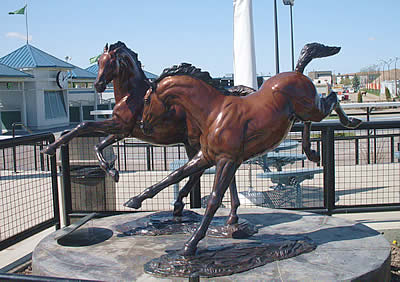
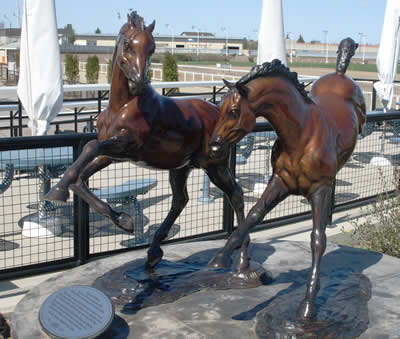
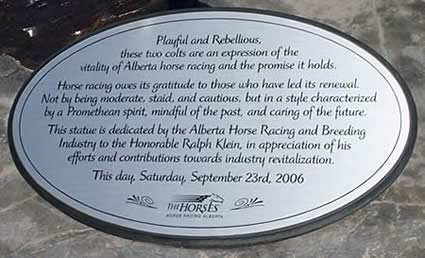
Learn About the Process of Making a Bronze Scupture
From Clay Original to a Bronze Copy: The Lost Wax Process
Lost wax casting today, except for some mechanization, is basically
the same process the Chinese developed in the 2nd millennium BC.
Bronze was one of the first alloys developed by ancient metal workers
and is a combination of copper and tin. A unique property of molten
bronze makes it the most popular metal for casting statues. Molten
bronze expands as it cools, to fill every detail of a mold, and as it cools
further it shrinks slightly and so the final casting does not stick to the
mold.
The artist submits an original creation, I use clay--it could be stone,
wax, wood or pottery.
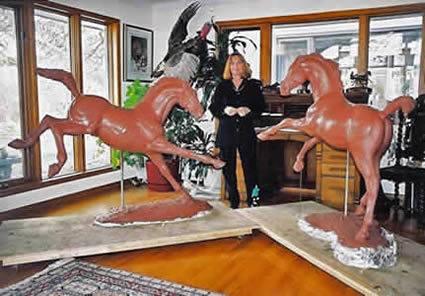
Elaine with her original creation of "Young Turks" in clay
MOLD
A mold is made by coating the original image with a silicone rubber
material
making two halves, then a fiberglass or plaster outer shell
is added to the back of
each half to give strength and rigidity to the
mold. Once the molds are made, they
are coated evenly inside with
wax. The halves are then bound together and filled
with molten wax
to complete the image being created.
THE WAX
When the wax has cooled the mold is peeled away revealing a wax ‘positive’
which duplicates the original sculpture. This image is then ‘chased’ a process whereby seam lines or flaws are erased
by a touch up with a heated tool leaving a wax image as close to the original as possible.
SPRUEING--CERAMIC SHELL CASING--LOST WAX
Wax rods are attached to the finished wax positive and
eventually
will become hollow gateways for the molten bronze to flow through
upon final casting. The
‘sprued’ wax copy is dipped repeatedly
in a slurry of liquid silica, then in sand to create a ceramic-type shell
which is finally cured in a kiln, where the wax melts away (‘lost wax’ process) leaving a negative space and the impression of the wax
on its surface. The shell is tested with water after cooling to check
for cracks or defects and then heated again up
to a high temperature
to withstand the ‘pour’.
THE POUR
Bronze ingots are heated in a crucible (2000F) and poured carefully
into the shell.
Upon cooling the shell is hammered or sand-blasted
away leaving the rough bronze which will be further chased, welded and ground to a fine finish.
THE PATINA
At this point the bronze is a bright yellow gold and it then goes
to the patinating
stand to be coloured to the artist’s preference
using chemicals which are applied to either a heated or cooled
surface with brushes and a blow-torch. Hot wax is burned
on to the surface to protect the piece from ultraviolet light
and to slow
discolouration by oxidation.
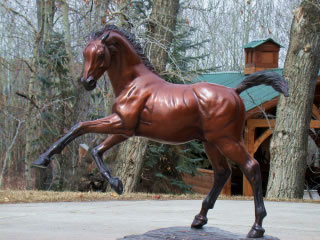
Given the above, no one need wonder why there is no quantity
discount on a number of the same bronze or wonder why limited
edition pieces are so expensive. Further, the mold is only good
for a certain number of castings before it loses its definition
and integrity.









